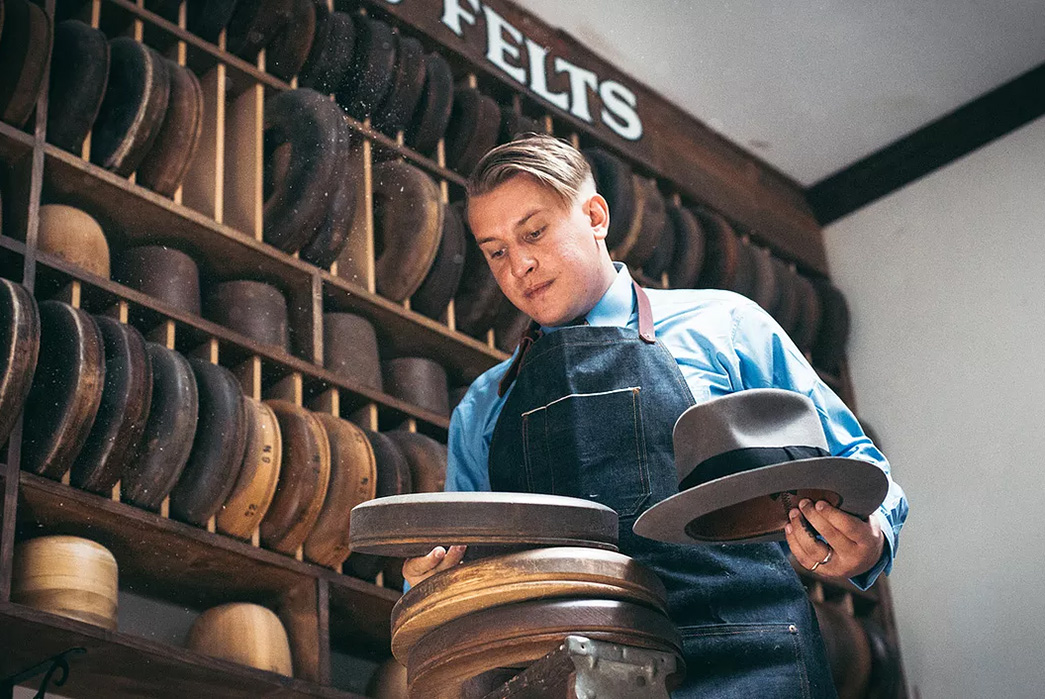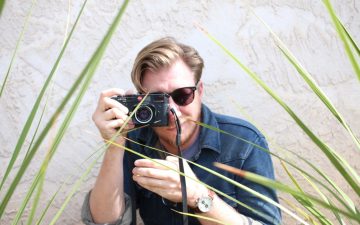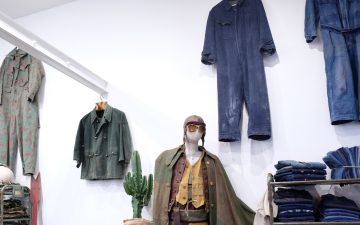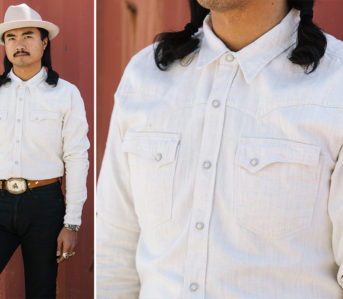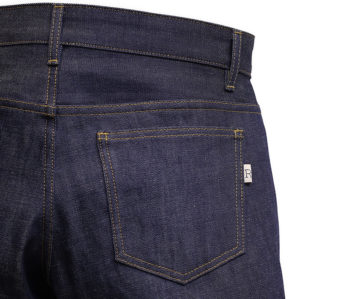Driving up and away from L.A.-proper into Altadena is a little bit like going back in time and pulling up in front of Wellema Hat Co. really makes you feel transported to another era. I sat down with Cody Wellema, the artisan behind this now-beloved hat brand to learn more about him and the dying trade he’s trying to keep alive.
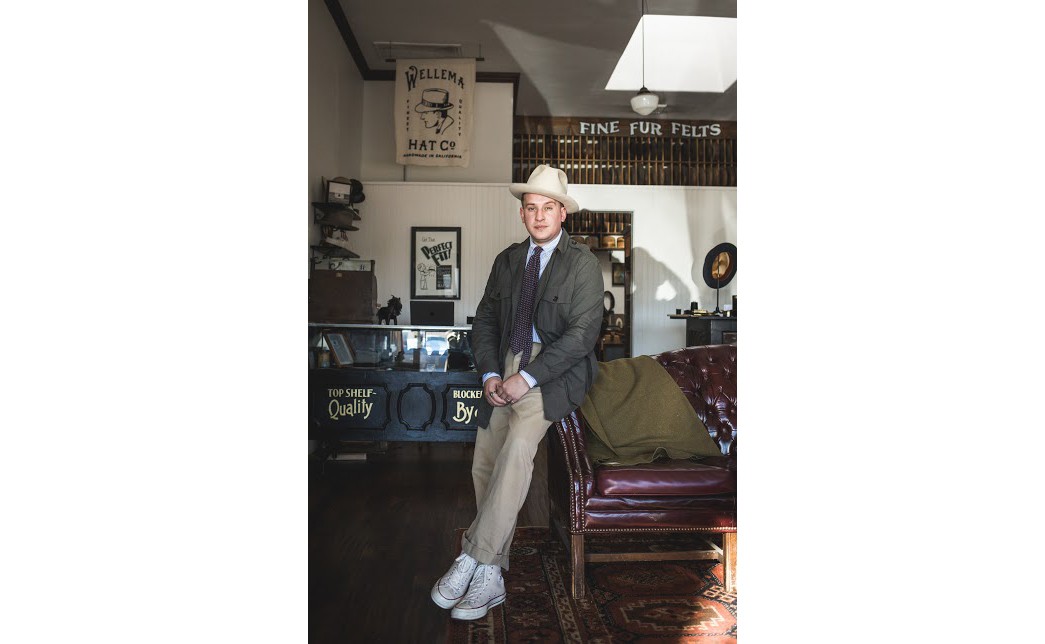
Cody Wellema
AM: Okay so let’s start with the basics. Who are you, what do you do?
CW: So, my name is Cody Wellema and I’m a hat maker. Wellema Hat Company, obviously is based off of my last name. I found a… so with hat making, not to deteriorate from the question, but there’s no real text or textbook or school. There’s nowhere to learn this, essentially. There are a couple of books that were published back in 1913 and 1917, and one of them in the first chapter kind of tells you… it’s so fast when I found it I was like oh, my gosh I struck gold. But it kind of guides you on how to set up—there’s a blueprint of a hat store, where you should put your workbench and this and that and how to get in the community. You should set up next to a barbershop because they pull men and all this kind of stuff.
In the first few paragraphs, it talks about how you should fund your lease and then open under your last name, you know, “blank hat company”. And I was like, “Perfect—that’s what I’m going with.” When I was trying to figure out what to name our company, I already had a vision of family stuff in mind and when I saw that, I was like, “That’s perfect.”
AM: So, you’re self-taught.
I understand that a little bit more now because the majority of hatmakers are some form of that self-taught. Really down and dirty, because for a long time there hasn’t been a lot of knowledge and history of learning this. So where I’m at now, I understand more because I get people all the time now—weekly—that are calling me or stopping in, “Hey, can I learn, hey, where do you get the material?”
I think what I do has always been around, kind of classic and you know, I can do anything for people, but certain hats are very trendy right now. And so there’s a lot of kids that want to be cool and have a name for themselves and start this cool brand and be hip and super-fashionable. I can tell that right away. So when people come to me like, “Oh, I wanna make hats like this,” I can tell they’re trying to be just… they don’t care about hats. They’re just trying to be cool. So, when it comes to where hats come from and the history and the passion for actually crafting something with your hands, they’re like, “No, no I don’t want to do that.” I’m not going to tell you anything because you’re just trying to be cool. So I understand that more now, the reason I couldn’t get an apprenticeship. Not that I was that person trying to be cool, but it’s just harder off the bat to do it.
After I gained a little respect in the community of hat makers, I finally started getting some tidbits from some old-timers. Then once I turned that corner, I got a few morsels and, “Okay, come on over to the shop and let me show you some stuff.” But even then it wasn’t that much. It was a lot of late nights, 3-4 in the morning, sitting there in the kitchen literally crying, bloody fingers from poked needles and burned hands from irons, and I’m just like, “What am I doing? Why did this turn out like this? I have no idea why.”
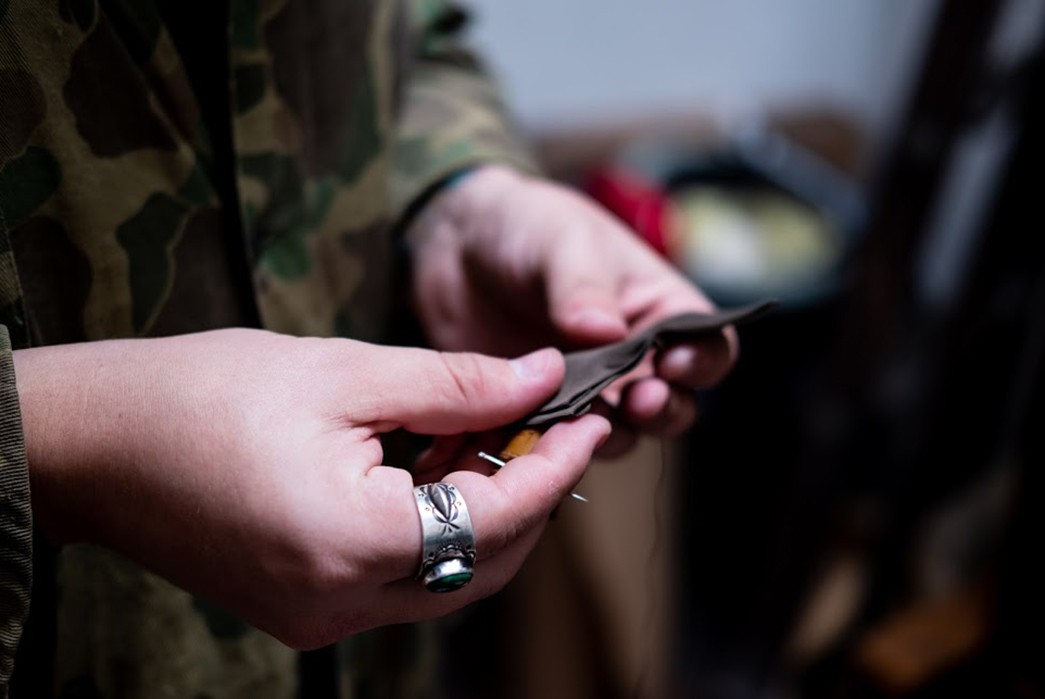
There was a lot of that and a lot of reverse-engineering, collecting and finding old vintage hats and then slowly taking them apart and seeing how they were built, and then putting them back together. So you know, taking the stitch off, etc. Mostly self-taught, reverse-engineering and then yeah, a few tidbits from some old-timers along the way.
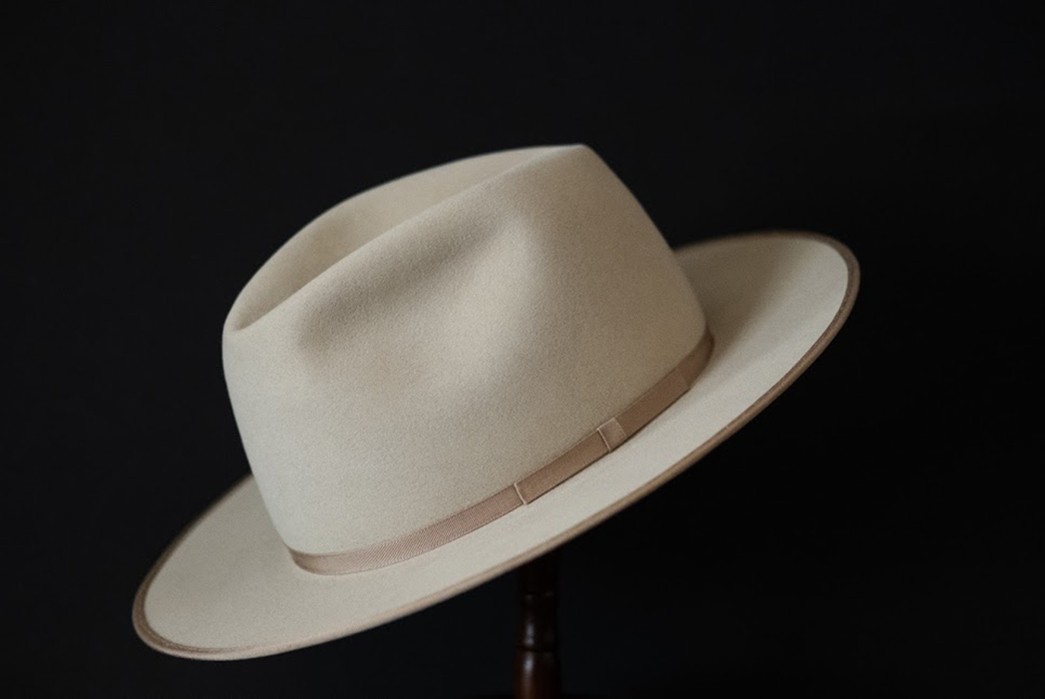
AM: So where did this interest come from? What did it spawn from?
CW: Somewhere along the way, I became really fascinated… I’ve never been good with academia in school and stuff like that, but I’ve always really loved history. Anyway, somewhere along the way, I became fascinated with old music. Started listening to a lot of jazz and blues. Started getting into silent film, not only just watching the staples like Chaplin and Buster Keaton stuff like that, but started reading books on different studios and… you know just kind of fun stuff like that and then getting into the 40s and 50s with black and white film with film noir, you know Bogart and all those guys.
So it kind of came from music and film, old stuff, and then from there, I started collecting all vintage clothing for collection, but also for personal wear. So after a period of time, my closet was pretty much pure pre-60s vintage, whether it was suits to casual shirts to accessories like ties and shoes. And then of course with that came hats, so I started collecting the hats.
But from all this… even as a kid I’ve always loved hats, whether it was a ball cap or beanies or flat caps or whatever it was, I always grew up loving hats. Then when I started getting into these older decades of time, you kind of saw hats everywhere like in photo albums, or a record from an old jazz musician like Fats Waller or something like that. Hats were just everywhere, so the hat became symbolic to me of that era or the Golden Age if you will, the 20s through the 40s or 50s or whatever you want to say. So whenever I saw a hat, I was automatically like, “Oh, that’s old school.” “That’s so 1930s or whatever.” So the hat was symbolic to me of a past time, and that’s really where the love for hats came from was this love for a time gone by.
That’s kind of how that happened and then I started collecting the clothing and the hats and then how we got to where we are today is I would take my vintage hat from 1940 and compare it to anything I could find today, even from some super fancy, high-end company. There was a night-and-day quality difference and also craftsmanship difference, and it was very apparent. I was like, “Why is it so different?” And then that’s kind of what sprung me into where we are today.
AM: So that first piece of felt you bought, that first block, when was that and was that in Santa Barbara or where was that?
CW: Yeah, that was Santa Barbara. So I started the company about 6 years ago give or take, about 2013 in Santa Barbara. I was making hats just slightly before that, but I mean I was kind of starting to figure out what’s going on here, putting things together and whatnot. So I started the company in Santa Barbara in 2013. We were there for 2 or 3 years. I started making hats in my kitchen. When my wife and I first got married up there, we had a little small one bedroom apartment. It was great; right in the heart of downtown. We loved it. Have you been to Santa Barbara before?
AM: Yeah.
Cody: Oh, my gosh, it’s such a good city. Anyway, so it started there, and then quickly outgrew the kitchen and found my first little workshop slash… I wouldn’t say store. It was in the heart of downtown where it was kind of tucked off of the main street behind a bar almost in a little alley. But there was a photographer, a leathersmith, and then me, so it was kind of this little artisan pocket tucked behind a bar, so it was kind of cool. It was all old brick, it was like, workshop in the front, this big workbench kind of thing, and then there was this backroom where a couch was. And we had little music nights and my friends would come and record music in there, and it was kind of like this little lounge.
So it started in Santa Barbara. Did all that there for a few years, and we just talked about how we’re going to be celebrating 3 years here.
AM: Wow.
CW: Kind of moved the whole operation here.
So I started researching what is retail rent like just in the area of Los Angeles, like anywhere, and also housing and stuff like that, but obviously for the business I was looking for stuff. So I first started looking on Craigslist. I found a place in Koreatown which I thought would be kind of cool. It was on the corner of 7th and Fedora Street. But that didn’t really pan out and then there were a couple other spots kind of in the downtown area, and then my wife was like, “Well, you know if we’re going to be in Pasadena. Why don’t you look in Pasadena?” I kind of wanted to be in the heart of Downtown, but it’s also kind of grungy. Pasadena’s really pretty and nice, and it’s got great food and architecture and history and culture and arts and stuff. And I was like, “Alright, let’s try it.”
Then I was looking at a place on Colorado, so we drove down here that day. We had a meeting to look at the place. We were in Santa Barbara still, came down, I said, “Okay, this place is pretty cool.” You know works, little pocket, and then we were driving around after the meeting and we ran into a flea market in Pasadena. And we love flea markets. Like I said, I love vintage and just junk if I see it. What can be cool in there? What gold can I find out of that? So we were at the flea market and we were talking to one of the vendors, who’s now a good friend of mine, Garrett, and he said, “You know, a friend of mine has a store just right up the road and there’s a spot open there. You may want to see it.”
We drove up here and I just felt I turned the corner. I was like, “Woah, it’s like a little slice out of middle-of-nowhere, but really cool.” It’s got great history and architecture, and the fire station is right here, and the police station right here. It’s like from the scene of a movie.
AM: Yeah. It’s awesome.
CW: So that’s kind of what got us down here.
AM: Well, it’s kind of funny that you’re inspired by classic films. Harpo Marx lived up the road.
CW: Yeah the Marx brothers had a little house right up the road and they would come up here on the weekends to do some writing, hang out and kind of get away. There are a lot of people back then and today that have houses just a block from here. Because like I said, it’s like 20 minutes to the studios, but they don’t have to deal with cameras or paparazzi or the hustle and bustle of parking and people stopping them. Like, there are celebrities that I know live right here, and they come into my store, and it’s fun to talk with them. Then somebody else will come in, and they’ll be like “Oh, so and so!” And they’ll look at me and be like uh [sigh of exasperation] and be like, “Here we go.” They’re so used to this block being like “Nobody talk to me about what I do. Just shake my hand and let me be a normal person.” You know? So when somebody strikes them like “Oh my gosh, can I take your picture?” They’ll be like, “Ah, dang it. I’m home right now.
I mean back then, too, there’s a lot of history, there’s a book here somewhere called “The Golden Years of Altadena”. There’s a lot of really cool history of different houses that were here and different people and what not. But it’s really cool. It’s a really cool pocket.
AM: So from crying in your kitchen at 3AM to now, was there a breakthrough piece? Was there a moment when you were like, “Oh, I feel like this is kind of working?”
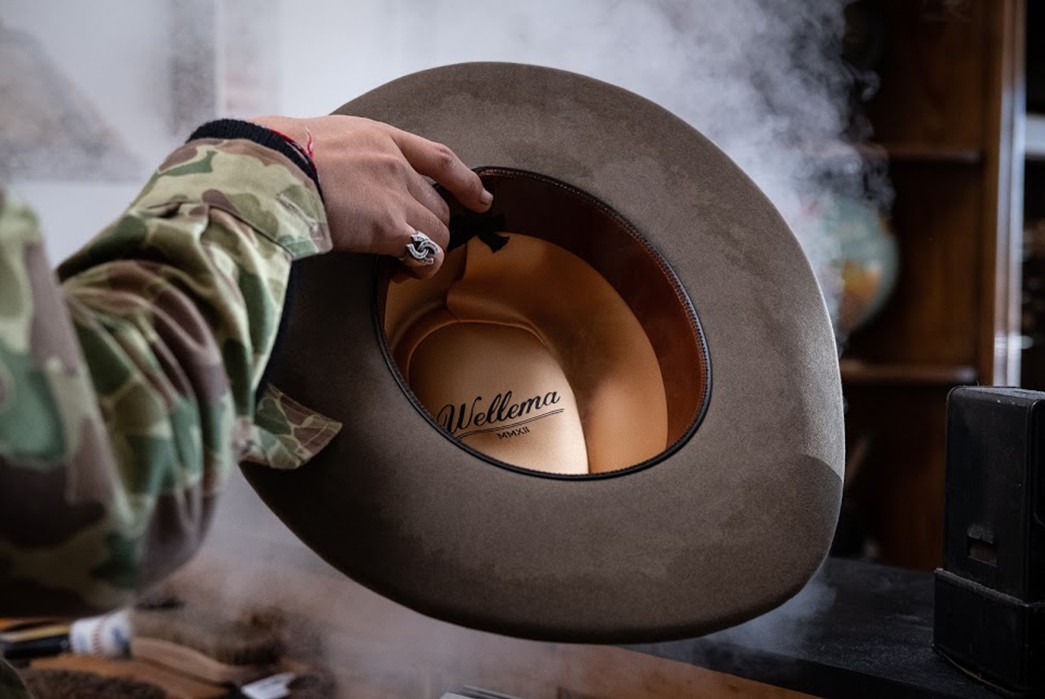
CW: Honestly, no. I feel like with hats—and maybe this is with every craft—I’m always learning. I feel like I have a long ways to go, still. I feel like there’s always a new thing to learn with hats or a different way to do this stitch or sew this or put this together or work the felt this way or that way. Sure, I have times where I’m like, “Okay, cool that hat turned out really well. I’m proud of it.” But I still think, “Man, how could I make a better hat?” How can I get the quality better? How can I pay more attention to detail on this aspect of it? How can I do this or do that better because it’s just… again, maybe it’s just that kind of artist mentality, but it’s hard to be 110% percent satisfied with your product.
So I still feel like I’ve not hit that breakthrough corner like, “I’ve made the best hat in the world like nobody else! Let’s lock up the door. Someone give me my trophy, I’m good to go!” I think there’s always something to be learned. I think there’s always something new to do. I think for any artisan, whether you’re a plumber or you’re making guitars or whatever, if you ever hit that plateau of “I did it,” then you’re going to sit there. If you’re not striving for more, even if it’s a tiny little step forward, then there’s no growth.
Not everyone is wearing a hat, and especially actually making hats. So for me, I really want to hone my craft, to really dial it in, to be proud of the hats. I just had an apprentice. I don’t know if you have ever met Akira?
AM: I did meet him, yeah.
CW: Okay. He was with me from Tokyo for a couple years. He just left like a week or two ago. He’s going to be in Los Angeles for a little bit. He’s helping his uncle and his family. They’re opening an art gallery in the arts district. And then he’s either going to be staying here or going back to Tokyo and doing his hat thing. He wants to start his own thing though he’s not exactly sure yet. But to be able to give him that information, the little bit of what I know, is super gratifying. To be able to pass this trade down and not let it die is really cool.
And he was one of those guys contrary to the others I mentioned earlier. He flew from Tokyo, he moved to Los Angeles to try and learn hats. He went to different states to find these hat makers and he was so intrigued and just enthralled by it all. I was like “okay, this kid has a passion for it.” He’s not just trying to get back to Tokyo and be the next guru or whatever. He wants to make a good hat. He knows hats. He’s studied vintage hats. He has a collection of vintage hats. He loves it. He went to school for sewing. He knows what he’s doing. And so I was like “Okay, I will train you.”
AM: So this is obviously a journey and a process, but what are some of the hallmarks you’re proud of in your process?
CW: That’s a really good question. Obviously, with the hats themselves, there are certain aspects when I look at old vintage hats and I compare today’s hats. There are certain aspects and milestones that I hit with my hats that I was very proud of. The way the felt was finished, like the softness and the hand of it all, the way that I was able to treat the felt, to work the felt to get it pliable and soft. There are a lot of hats out there today that are very rough and not cared for. So there are milestones in the hats themselves that I’m proud of as to the level of quality that they’ve achieved.
And then there’s stuff like opening a store. Not many people, not even my family from the east coast, have visited the store. They’ve seen stuff online, but they don’t know. Or I meet somebody at a bar, coffee shop or whatever, and I’m like, “Oh, yeah I have a hat store.” They automatically think like Lids or some store at the mall or something.
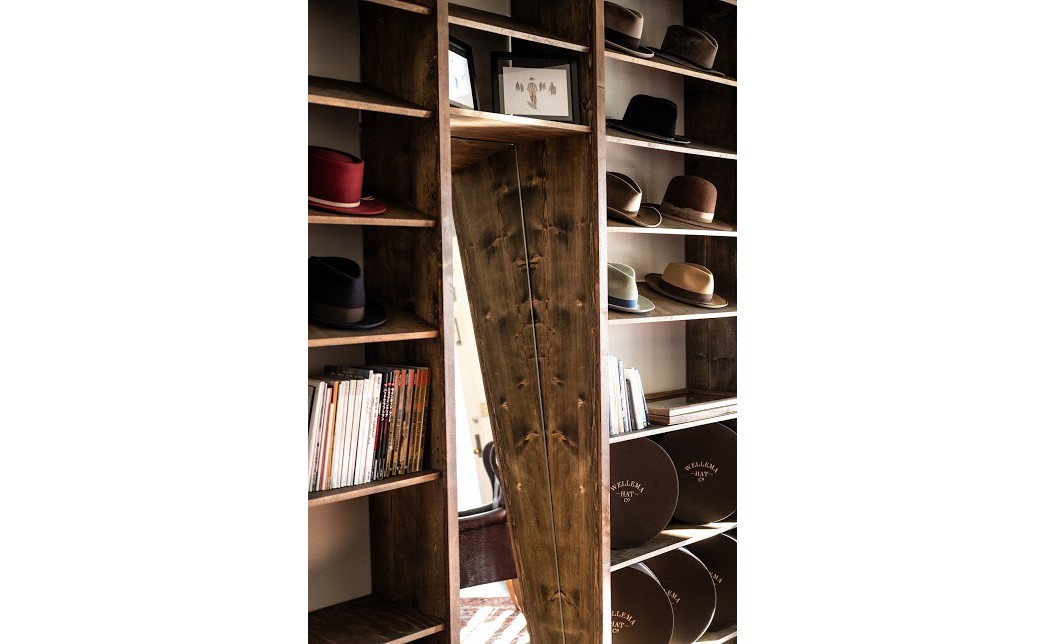
Inside the store.
So to have a store like this, to me, is a milestone because it’s not so much that I own a retail store. My goal with having a store was always to have a cornerstone for community. That’s why the couch is here and the books are here and the little bookcase, if you will, with magazines and stuff. Because the goal of my store isn’t to come in and spend your money. It’s come and congregate and hang out, and let’s have a conversation. You had a hard day? Cool, let me stop what I’m doing. Let’s hang out, let’s get a coffee and let’s hang out.
I think if you’re going to do retail, you have to do it with story and you have to do it with heart. If you’re going to open a store, it can’t just be to make money anymore. And that’s something where my heart’s always been, but I think for anybody that’s opening a store these days I think it can’t just be, “Okay, I’ve got to open a store to pay my rent and my bills and make money.” I don’t think that’s going to work anymore. I think it’s got to have a story behind it. I think it’s got to have some culture behind it and some history and a place for people. I think that’s really important these days.
I have no idea what you asked. Why I started talking about that. Oh, milestones. So opening a store for that reason is a milestone. I think travel is another milestone. I’ve always loved travel and traveling with the business has always been a dream of mine. To be able to not travel like a business guy. My dad had always traveled for work when I was growing up, but he goes to Ohio or whatever. Not so much like that aspect, but travel for the company, specifically.
Almost exactly a year ago, it was July or August of last summer, it all started falling into place. It worked out and I went to San Francisco for my first business trip for a trunk show. And San Francisco, that’s one of my favorite cities in the world. So we went up there. We were there for a couple of days and it was great. And then right after that, we got invited to go to New York. And then right after that, like a month later, I went to Tokyo and Hong Kong and then came back for the holidays. And then right after the holidays we were just in Florence and London, and then came back and all these places were for… I’ve got a case back there that houses maybe a dozen hats. So I packed up the hats, and I go to these stores. I almost feel like an old traveling hat salesman. I’ve got my case, and people are always looking at the airports and when I’m walking down these cobblestone streets with this giant coffin-looking thing in my hand, and I’m in a suit or something like that, and they’re like, “Who the heck is this guy?” I just feel like this weird traveling salesman from some 1930s comic book or something, you know?
AM: The hat in the average man’s wardrobe is not as prevalent as it was during Bogart’s day. So how do you get somebody hooked? Do you kind of pitch the hat to somebody?
CW: That’s a great question. I don’t know. I don’t see myself or my company as a salesman company. I would say 95% of the time, people are coming in here for us or for the hat or with an idea. The majority of the time, they come up it’s usually an appointment or something like that, so they know what they’re doing, they know what they’re getting themselves into even if they don’t know hats at all. They know what they’re coming for and they’re ready to spend whatever.
But there are people that come in whether it’s an appointment or they’re just walking in, and they’ve never worn a hat like this. They’ve never really known anything about a hat like this, but they love the idea of it. Or they saw it in a movie and they’re like “Oh, I love the way Johnny Depp looked.” How can I accomplish that same look? And then I think that’s where it comes to my professionalism of knowing what hat will look good on somebody.
One of the number one things I get in here is people who think, “Oh, hat shop, this is crazy.” Next thing they’ll say is “I’ve never looked good in a hat. Hats look terrible on me.” And that’s a blanket statement anywhere I go. Even if I meet someone and tell them I’m a hat maker, the first thing they say to me is, “Ah, hats never look good on me.” I do believe that everybody can look good in a hat and can wear a hat really well, but it comes down to the proportions, style, and shape to frame the face and the body.
So when the majority of people say that hats never look good on them because they go to Macy’s or some store, some cool hip store, and they just pick something off the shelf, and put it on and it’s way off in proportion, and it doesn’t look good on them… they’re right. But you haven’t found the right hat that will look good on you. Because with different face shapes, whether it’s a slender face, a more round face, tall, short in height, broader in the shoulders, all that stuff… there’s a lot of stuff that goes into it that people don’t realize.
There are so many different things that go into it. So I think that’s a starting point for people. That’s almost my sales pitch. “You can look good in a hat. Let me show you what will look good on you.” That’s kind of how I work in here.
AM: So I might be doing myself a disservice to come in and say, “This is the kind of hat I want.” I need to be able to be flexible to find the right fit.
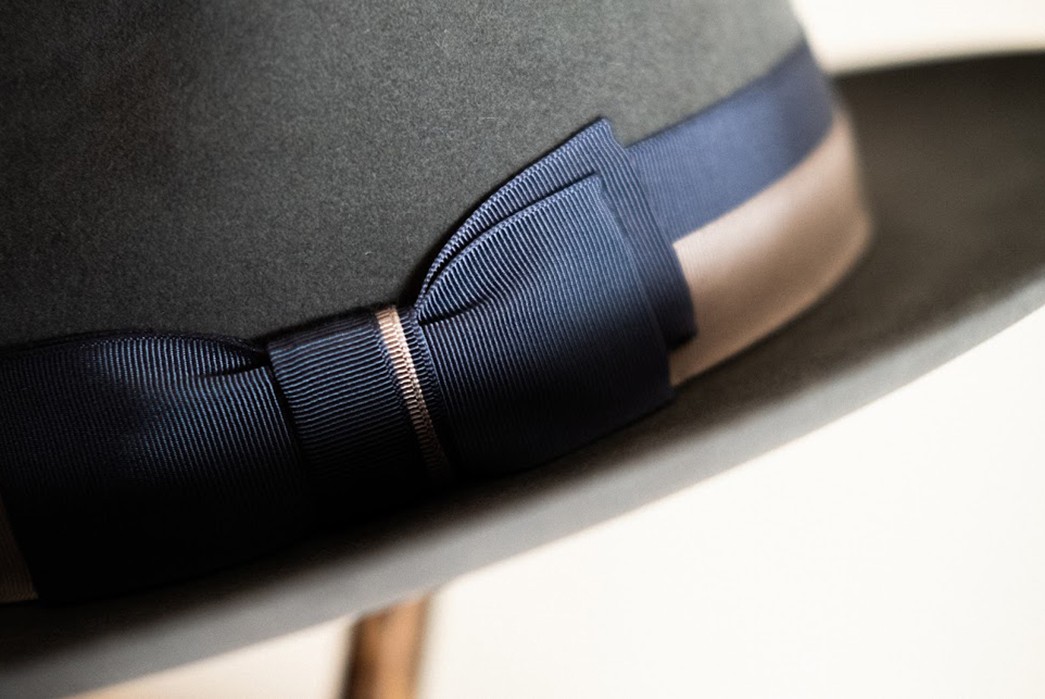
CW: Yeah. A very easy example is a lot of people come in here with a photo of Bogart or their grandfather. Like a week ago this guy actually brought in this big frame, his grandfather from like the mid-30s in Japan. He’s like, “I want this hat. I want you to make me my grandfather’s hat.” I was like, “Cool. Just so you know, this hat, like the 30s-style hats, were a lot more bulbous, meaning a lot more straight, not a lot of taper.” The proportions were just different back then. And most people get scared of them because they are a lot taller when you put it on it feels like there’s a mountain on your head.
So people come in with the idea of “this is what I want.” We can take that element of the 1930s and kind of modify it and make it a little more contemporary to frame you. For instance, maybe it’s giving a very contemporary style tapered fedora for you, but maybe we put true 1930s vintage ribbon on it. So you can still say “1930s” with your hat. We need to tweak it to frame you well, but we can somehow pull whatever element you’re looking for so you can say that cool factor.
AM: That’s smart. I don’t think I was taking the customization into account.
CW: And again, some people come in here, like a normal retail store and they find something that’s just sitting here and it works for them. But I also tell them I’m not trying to make quick, easy money. If you put on a hat and I truly don’t think it looks that good on you, I will let you know it looks okay on you, but I think we can get it to look better if we just add a quarter of an inch to the brim. If we do this, let’s really make a good hat because I don’t want you looking bad in one of my hats. It’s like you’re my billboard, essentially.
There are a lot of people that look bad in hats because they chose the wrong hat. I’ve seen so many people, it gets me every time. Like, if I’m at Union Station or something, and someone’s got their hat fully on backwards. They just don’t know what they’re doing. And it’s such a funny thing because again, hats are very fashionable again right now. Whether it’s women or men. So someone just grabs something and puts it on them to fit that mold of fashion, and that’s what always kills me. Let’s actually make you something that’s going to be worth your time down the line, not one that’s a fashion trend that will end in a year. Something that you’re actually going to be able to wear past that trend, you know?
AM: What is the specific trend?
CW: So right now, for both men and women, a wider brim, more like table-top. And kind of a distressed almost artistic kind of beat-up and burnt to make it look like it’s from the 1930s or like some cowboy wore it like it was John Wayne’s hat, but it’s not. Maybe a little splatter of paint and some weird stitching.
AM: Who are other makers and people around that are folks who inspire you?
CW: Um, honestly anybody that has heart behind what they do. Going back to what I said, if somebody is in a trade or a craft or starting a brand or a store that’s going to be somebody or be cool, that’s not inspiring to me. But if they have this heart for something, for a certain reason, that’s really what inspires me. So I have a friend who I was actually just on the phone with yesterday. You may know him, Brian Truong? Brian the Boot Maker?
AM: Oh yeah, oh yeah.
CW: He’s somebody that is just a phenomenal character. He’s a great person. He’s got this humble little shop in downtown LA, but his waitlist is like over a year right now.
AM: People go nuts for his stuff.
CW: Insane. And it’s a high price point, you know? But he makes good quality stuff. And if you meet him, he’ so humble, and he’s so… have you ever met Brian?
AM: I have not.
CW: He’s so humble, and he’s so hardworking. He’s almost like reserved and timid, kind of. But he’s just like, “Yeah, I make boots.” And people go nuts over his stuff, you know? As they should be, it’s insane quality, but he’s so humble and he’s got such a passion for it and he’s got such a respect and honor for his teacher, who’s just like this older Hispanic guy that had this shoe store for repairs and stuff. But he’s got such this profound honor for him for teaching him how to make. Brian is such a unique person. I wish everybody in the craft and trade world, whether you’re a plumber or whatever, were like Brian because he’s phenomenal. Again, with his heart behind the whole thing, and obviously his product is really inspirational. It’s to the “T.”
AM: So it seems like for you, it’s kind of where talent meets humility.
CW: Yeah, essentially. And the same with music. Somebody could pick up a guitar and learn to play it, but if somebody really has a passion for where music came from, like studied music, and knows all these weird facts about music and weird musicians from the 40s or the 60s and they’re like “Oh, yeah this one guy from like Hoboken, New Jersey…” Or they’re like, “So-and-so sat on their front porch and became famous or built this guitar out of a shoe,” or whatever. They know all this weird stuff. To me, that’s very inspirational because they have a passion, they have a knowledge for what they’re doing. And if they’re good at it too, it’s awesome. But even if they suck, if they have a passion for something they’re trying really at, to me that’s still really inspirational. That’s really what I’m after. When I see somebody doing that, I’m like, “Can I make you a hat?” Let me just gift you a hat because I love for people to wear my hats that just have passion and heart behind what they do, whether they’re super good at it or not that good.
I made Leon Bridges a hat a long time ago, and it was before he really got famous. I want to say, he had a little YouTube song or maybe something on Instagram. I don’t know what it was, but at the time I remember he had only 3,000 followers on Instagram or something like that. And I was like, “Man, this kid. He’s got soul and heart behind his music, and I can tell he’s got this passion for it. Can I make him a hat?” This was at my early stages, too. I should not have been making people hats at this time. I made him a really crummy hat. He probably looked at it like, “Man, this is a junky hat.” Anyway, I should not have been making hats at the time, but I could just tell he had this heart and soul behind his music and all of a sudden he blew up into this huge thing—as he should because he’s doing something different and unique.
[We were momentarily interrupted by an eager customer, arriving before doors even officially opened for the day. He was picking up his second hat from Cody and he had something to show us. He’d actually painted his first hat. He stayed and chatted and raved about his newest acquisition and when he left, we were all smiling. We returned to the interview, to wrap it up before the shop opened.]
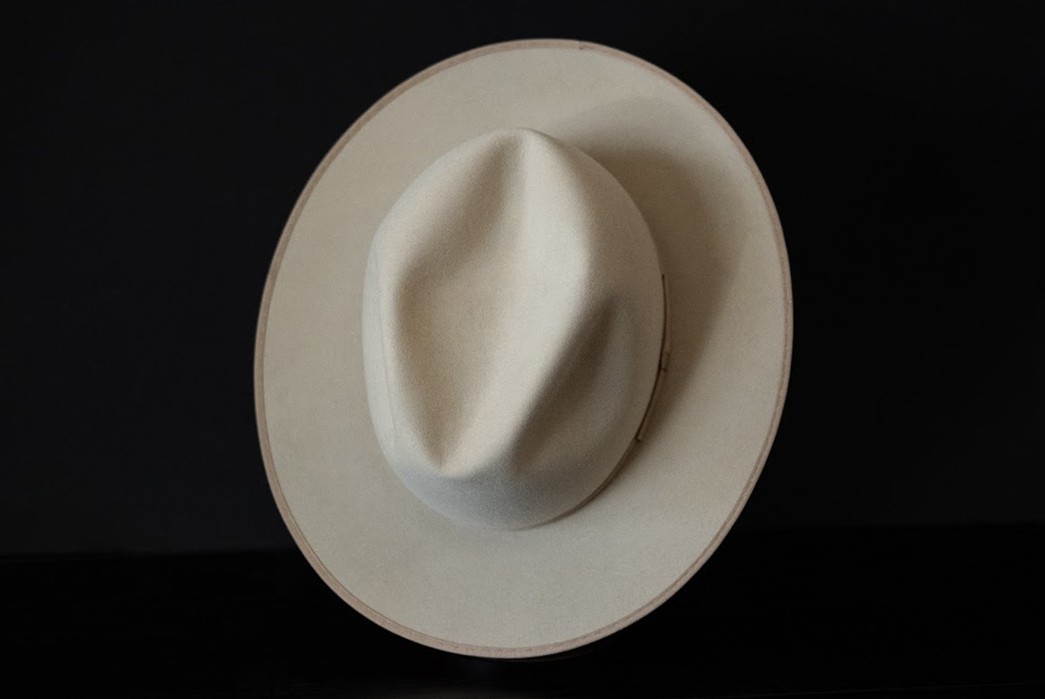
AM: Any sort of last impressions to let the good people know?
CW: I think that right there is a really good example… I don’t know if example’s the right word, but it might come to me. So many times I get the question, “Who’s your clientele, who comes in to get hats?” And there isn’t a person. I have my aesthetic and my style and whatnot, so people think it’s all the suit guys, all the sartorial guys coming in. And that’s not true at all. I really enjoy what I do because every single person that comes through the door for a hat is different than the next. I’ll get somebody like that who’s a typical dad. Shorts, running shoes, and a tee-shirt, but he’s wearing like this $600 hat on his head.
But then the next guy that’ll come in in an hour is like in a full suit and tailored well. And then the next guy’s like in a full denim ensemble. Every single person is different. And then I’ll get the mom that just dropped the kids off at school and wants a hat to walk their dog in and go to some event, just a wide brim, you know, whatever. And I’ll get the Coachella girl that comes in that wants the distress and all, so like every single person is different, and I really enjoy that because I get to meet different people. I get to interact, I get to learn about different people and you know, so this hat’s going to be moreso for style and kind of coolness, okay this hat, you work on the ranch, you’ve got a barn up the road, it’s more for function. It’s kind of fun because it always keeps me on my toes.
Every hat is different than the next. As much as I, again, classic classic classic classic, same same same, when someone comes in here they’re like whatever but each hat is really truly tailored to each person whether it’s for the fashion or the style or the utilitarianism, all that stuff it’s pretty cool. Kind of keeps me on my toes.
A lot of ladies come in here and because the shop does have a little bit warmer more masculine feel to it, they say, “Oh, men only?” No no no. A hat is a hat is a hat, like a head is a head. The hat can sit on anybody, put it on your dog if you want, you know? Like whatever it may be.
So it’s kind of fun to be able to do something like this because some companies and some brands are very specific to their audience and have a great targeted audience, but I get to present my own personal style and my aesthetic as far as the company goes to just me. This is my little man cave or clubhouse if you will, and people get to come in here. But everyone that comes in here is so different, and it’s pretty fun to be able to interact with them and make some different people hats, and that’s pretty cool. So and that’s a perfect example because not everybody is like him, very unique, with a winery, looking like a typical dad and then Mr. $6,000 Tailored Suit comes in next and I’m like “Alright, let’s do that,” and then the cowboy comes in and it’s like “Alright, let’s make you a cowboy hat.” It’s pretty fun.
For the full Wellema experience, be sure to head to Altadena, CA. But in the meantime, check them out on their website.

